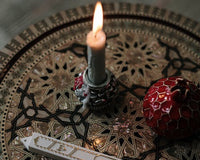You’ve probably seen people wearing Tallits before. Do you know why they are worn and what they represent?
Firstly, a tallit is not just a typical scarf or shawl. It is a garment with special significance that is worn by religious Jews and others as a prayer shawl. It has specially knotted fringes (called tzitzit) that are twined (twisted together, composed of two or more thinner strands). The part of the tallit that is cloth is known as the “beged”, most typically made out of cotton or wool. Occasionally silk will be used when making tallit gadol (typically a larger tallit made to be worn over the clothes and to rest over the shoulders).
Wearing a tallit is a physical symbol that one’s heart and mind are being prepared for prayer. A tallit is a way to inspire reverence and devotion toward God. One of the most (if not the most) facets of the tallit is it’s deliberate, specialized, and detailed fringes (the tzitzit mentioned above). These are tied to each corner of the tallit, and are based on a specific passage in the Torah: Numbers 15:47-41. This passage gives instructions that the wearers of a “four-cornered garment” are to wear such so they can remember the commandments of God.
There are many layers to the symbolism of the tzizit. Firstly, take the gematria (or the numeric value) of the word tzitzit, which totals 600. Then when the eight different strings, and the five knots upon each fringe are added, the total equals 613. This is the number of mitzvot (traditionally).
Now take into account that every tzizit is twined (or wound) 26 times. That is the equivalent numerically of the ineffable divine name. The sum of the strings and knots is the gematria of “one” or echad, which represents of the One.
What constitutes a tallit? It is a four-cornered garment bound by specially tied fringes, one at each edge. Every aspect of these tzitzit is symbolic. The numeric value (gematria) of the word tzitzit is 600; combined with the eight strings and five knots of each fringe, we arrive at 613, the traditional number of mitzvot.
Each tzitzit is wound 26 times, the numeric equivalent of the ineffable divine name. Since 13, the sum of the strings and knots is the gematria of echad, "one," the tallit wraps us, as it were, in the presence of the One, whose divine charge guides us no matter which of the four cardinal directions life might lead.
The Talit can also symbolize deliverance, as it is very intimately associated with the period the Hebrews spent in Egypt. Furthermore, the tallit can be a symbol that represents coming of age when it is received at a bar or bat mitzvah-- sometimes a focal point of the ceremony.
Finally, a tallit is a powerful symbol of solidarity and accord among those of Jewish faith, a unifying beacon of devotion to God.
Do you want to further understand the symbolism of the tallit, and how it can be used? Learn more here.






